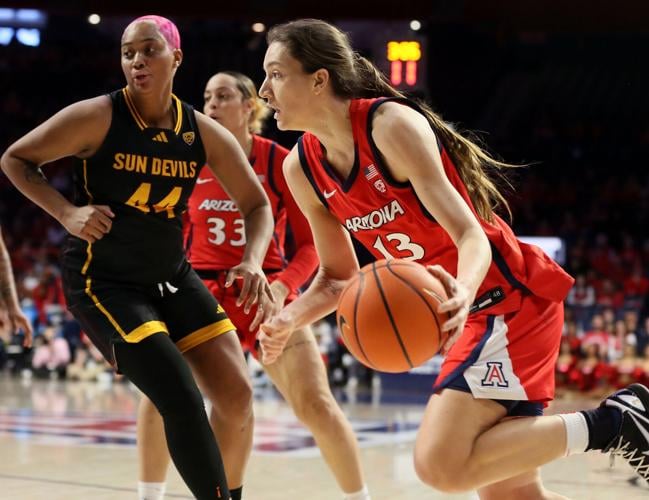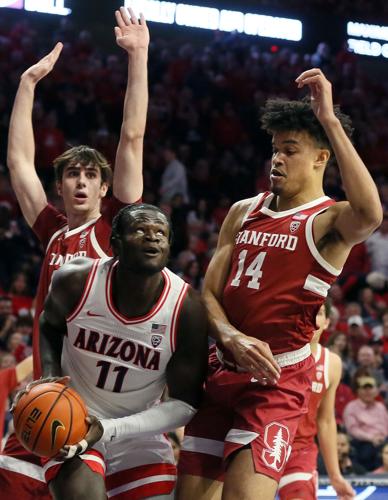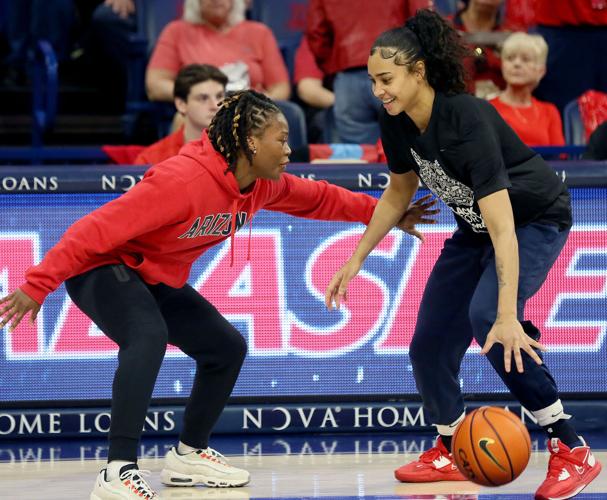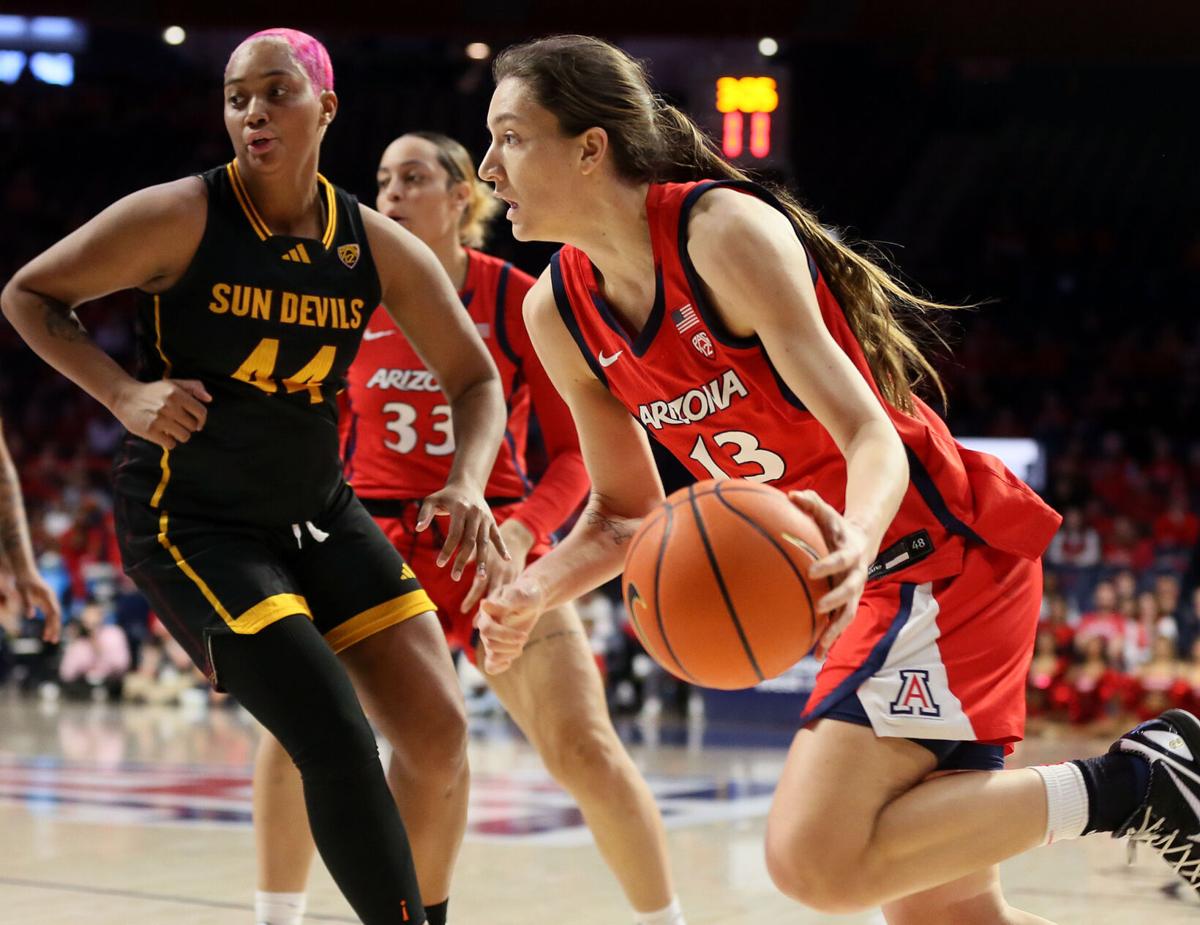Eighty minutes of basketball. Two Arizona victories by the exact same margin.

Michael Lev is a senior writer/columnist for the Arizona Daily Star, Tucson.com and The Wildcaster.
It was a rare and triumphant day-night doubleheader for the Wildcats on Sunday. It began with an enduring rivalry and ended with a matchup we might not see again for a while.
Here are 10 observations — five on the Arizona women and five on the men — from a long, fun day at McKale Center:
WOMEN: ARIZONA 63, ASU 52
1. Helena Pueyo can positively impact the game without scoring — not that Adia Barnes wants that. If anything, Pueyo can be too unselfish at times. On four occasions this season, she has failed to score; the Wildcats are 1-3 in those games. Barnes wants Pueyo to be aggressive on offense, and she showed she has that in her with seven second-half points. She finished with a box-score-stuffing stat line: 11 points, six rebounds, four assists, three steals and three blocks. She also guarded the Sun Devils’ top scorer, Jalyn Brown, who made only 4 of 17 field goal attempts. One play in particular stood out: After stealing the ball from Trayanna Crisp near halfcourt late in the second quarter, Pueyo immediately recognized that Arizona had a two-on-one. So as she dribbled, she veered to her right to create space. She then fed Courtney Blakely for an easy layup. Heady stuff.

Arizona forward Esmery Martinez, right, looks for an Arizona State player's contact lens on the floor in the first half of their game.
2. When I asked Esmery Martinez about playing with Pueyo, the fifth-year forward smiled, did a little dance and made the heart symbol. “I love it,” Martinez said. I bet Martinez’s teammates would say the same about her. She’s tough as nails. Martinez was vomiting before the game because of a migraine. Barnes thought she’d be limited at best. She ended up playing 30 minutes, compiling 18 points and 15 rebounds. Arizona was plus-20 with Martinez on the floor. It was a Jordan Flu Game. “I pushed through, and I’m here,” Martinez said. That’s what a veteran leader does.
3. Freshman Breya Cunningham scored eight of her 11 points in the fourth quarter, making all four shots she took. It’s amazing what can happen when you’re available. Cunningham’s biggest issue in her first college season has been foul trouble. She has committed the most fouls on the team with 82, averaging nearly four per game. She has fouled out five times. All too often, the fouls are committed far from the basket or even off the ball. Barnes explained that it’s what happens before the actual fouling that’s putting Cunningham in disadvantageous positions. Reacting and rotating a tick late forces her to reach instead of using her God-given skills — size and timing. She’s learning as she goes.
4. Barnes went on a screed after the game about social media, distractions and culture. The question preceding it was about since-deleted social posts by former player Maja Nnaji, who said that a “toxic environment” contributed to her departure from the program. That comment led many to wonder whether that was a factor in other players leaving as well. Barnes’ bottom line mirrors my own thoughts on a complicated situation: If the culture was so bad here, the Wildcats who’ve stuck around wouldn’t play as hard as they do. “You can see it on the floor,” Barnes said. “If we weren’t cohesive and didn’t have great culture, they wouldn’t fight like they did. ... Those girls, they all say 10 toes down, they all fight. They have my back, they have each other’s back ... and that’s the most important thing for me.”

Arizona guard Kailyn Gilbert, left, plays around with forward Esmery Martinez during warmups before the Wildcats’ game against Arizona State.
5. All that being said, the situation involving Kailyn Gilbert is bizarre. Gilbert, Arizona’s leading scorer, hasn’t played since Jan. 21. Barnes will only say Gilbert is “unavailable.” She wore a brace around her midsection Sunday — presumably for the back issue that Pac-12 Networks reported she was dealing with — but Barnes implied it wasn’t a physical injury that was keeping Gilbert out. She also was dribbling the ball and maneuvering around the court during warmups and linked arms with Pueyo and Isis Beh during the national anthem. It’s as if Gilbert is here yet not here at the same time, like “Ghost” in “Ant-Man and the Wasp.” Clarity might never come, but it seems more likely than not that Gilbert won’t be part of the mix moving forward.
MEN: UA 82, STANFORD 71
6. UA guard Jaden Bradley scored only five points. He made only 1 of 5 shots. He didn’t have a steal or a block. Yet his plus-minus was plus-17, second-best on the team. What does that tell you? That Bradley had a profound influence on the game, especially on the defensive end. He and fellow reserve KJ Lewis (more on him in a bit) changed the tenor in the second half with their relentless defensive effort and perimeter pressure. “In the second half we came out with more energy, defensively we came out with more intensity,” Bradley said. “That’s what wins games at the end of the day.” Arizona outscored Stanford 48-26 in the second half. The Cardinal shot only 28.1% in the final 20 minutes. Bradley played a pivotal role.
7. Lewis was even more impactful. He did it on both ends, scoring 10 second-half points on 4-of-5 shooting and compiling three “stocks” (two steals, one block). Even in the final minute, when the outcome had been decided, Lewis stuffed Stanford’s Michael Jones to set up a thundering dunk by Caleb Love. Tommy Lloyd has mentioned many times that Lewis can influence a game by sheer hustle and effort; that was on display and then some in the second half. Lewis also happens to have NBA size and athleticism. I still think his wisest course of action is to come back next season and expand his offensive role and repertoire. But he could play himself into this year’s draft with more performances like Sunday’s.
8. The better Bradley and Lewis play — and the more Kylan Boswell struggles — the more UA fans will clamor for a lineup change. I’ve advocated for one as well, if for no other reason than just to see what happens; if you’re going to experiment, now is the time. What would the Wildcats look like with Bradley running the point and Boswell coming off the pine as an instant-offense guy? Could that be his best role? Right now, it’s unclear what that is. On consecutive possessions in the second half, Boswell made a gorgeous no-look entry pass to Oumar Ballo for a dunk — then sloppily turned the ball over on a fast break. Lloyd continues to support Boswell, calling him a “super-important part of this team.” He’s also a player who, nearly two years into his UA career, is still trying to find his way.

Arizona center Oumar Ballo (11) looks up at the basket as he’s defended by Stanford forwards Spencer Jones (14) and Maxime Raynaud (42) in the first half of their game at McKale Center on Sunday.
9. This is a Ballo appreciation post. All too often, we as sports fans and pundits harp on what a player isn’t rather than praise him or her for what they are. Ballo’s game isn’t aesthetically pleasing all the time. He isn’t a modern, uber-athletic big who can shake a defender with a crossover or drill 3-pointers like a point guard. His free-throw shooting is an ongoing misadventure. But he plays with great effort. He’s a forceful, old-school presence in the post. And he’s producing. Ballo blitzed the Bay Area schools for 40 points on 16-of-20 shooting, adding 26 rebounds and three blocks. His season averages are in line with last year’s after a somewhat sluggish start. “It’s time,” Lloyd said, clearly referring to Ballo’s status as a fifth-year senior. “He’s rising to the moment.”
10. Something I’ve learned quickly in my transition from football beat reporter to chronicler of multiple UA sports is that the expectations for men’s basketball are absurdly high. Even solid wins can feel like losses as fans lament the Wildcats’ weaknesses and forecast doom come March. I get it; Lute Olson set a standard here that hasn’t changed, nor should it. But when it comes to this particular team and season, I view the occasional hiccup as a good thing. The Cats are learning how to win when they don’t have their best stuff. They’re building calluses and character for the inevitable NCAA Tournament game when their shots aren’t falling and the other team can’t miss. Better to figure it out now than then.
VIDEO: Arizona men's basketball coach Tommy Lloyd discusses his team's 82-71 win over Stanford — the Wildcats' avenged an earlier loss to the Cardinal this season — on Sunday, Feb. 4, 2024 at McKale Center. (Courtesy Arizona Athletics)
VIDEO: Arizona women's basketball coach Adia Barnes discusses her team's 63-52 win over rival ASU — the Wildcats' fifth straight over the Sun Devils — and other topics related to her team on Sunday, Feb. 4, 2024 at McKale Center. (Courtesy Arizona Athletics)









